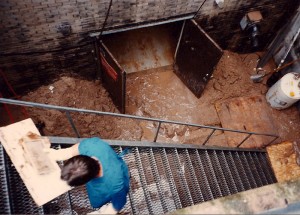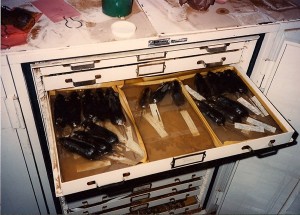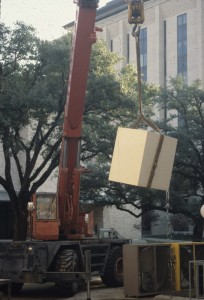The National Science Foundation (Biological Research Collections Program) has awarded nearly $500,000 to the Biodiversity Research and Teaching Collections (BRTC) at Texas A&M University (Voelker and Light).
This award will be used to fund the replacement of all cases in the bird and mammal collections which were heavily damaged in a flood event over 15 years ago. With this funding, the BRTC will be able to ensure the long-term safety and continued viability of these vertebrate collections, which number over 60,000 mammals and 15,000 birds. This award will also allow the collections to accommodate increasing numbers of specimens from active ongoing research programs. As a part of this work, the bird and mammal collections will update taxonomy, verify specimen identifications, and cross-reference specimens to genetic resources, all of which are critical aspects of collection management.
Additionally, the grant will fund graduate Curatorial Assistant positions, allowing the training and education of new museum-based researchers. Approaching its 75th year, the BRTC is one of the most active vertebrate collections in the state: the bird collection is the only active research-based collection in the state, and the mammal collection ranks among the top 20 in the western hemisphere. In addition to providing resources for basic research, the BRTC is a critical element in the Department of Wildlife and Fisheries Sciences curriculum, for which the collections host the lab sections of all vertebrate natural history courses. Over 200 undergraduates per year are exposed to, and are made beneficiaries of, the biodiversity represented in the bird, mammal and other vertebrate collections. Furthermore, the collections routinely sponsor undergraduate interns who participate in various aspects of collections management.
History of the Flood

Entrance to former space utilized by the Texas Cooperative Wildlife Collection the morning after the flood.
In the early morning hours of 30 October 1992, on the main campus of Texas A&M University, a water line associated with Sterling Evans Library building broke, flooding the BRTC housed in the building’s basement. The water, carrying a load of dirt and sand, rose to a level about 3.5 feet above the basement floor. About half of the scientific material in the BRTC was wetted and much was totally immersed for up to several hours. Ninety-six museum cases containing mammal and bird specimens were completely submerged in warm, silty water. Two ultra cold freezers holding the tissue collection were ruined and nearly one third were partially thawed. The computer used to catalog mammal specimens was destroyed. Original catalog cards for 45,000 specimens and approximately one-half of the field notes and curatorial paperwork were submerged.

Flooded case of rodents.
After the flood, it would have been impossible to simply dry out this vast amount of material without much of it molding or rotting. It was imperative that these specimens be evacuated from the BRTC and frozen as quickly as possible to prevent further degradation. The only way to dry such a large amount of material is by utilizing freeze-drying techniques. BMS Catastrophe, Inc., of Fort Worth, which specializes in flood and disaster recovery, had freezer trucks on site by noon the day of the flood. Water was poured out of the cases and case drawers, then the wet specimens were repositioned as well as possible, before being loaded into the freezer trucks, drawers and all. Skulls were dried with large dehumidifiers in a separate facility. Wet pelts were air dried on net hammocks. Small pelts were repeatedly rolled and unrolled to prevent stiffening. These techniques put the BRTC in a position to recover more than 90% of the collections’ total scientific value.

Specimen case being removed from former space by crane.
The cost for freeze-drying and associated specimen recovery was about $192,000. In 1994, the BRTC was physically moved from its basement facilities and storage locations to an off-campus building, where it remains today. The portion of the building housing the BRTC was suitably remodeled. The total cost of the flood recovery and moving to the new facility, which included renovation of the new BRTC space and new ultracold freezers, was about $460,000. The Department of Wildlife and Fisheries Sciences and College of Agriculture and Life Sciences at Texas A&M covered the majority of these costs. To date, the BRTC still retains and uses specimen cases that were water-logged during this 1992 flood. Funds received from National Science Foundation will replace those cases.